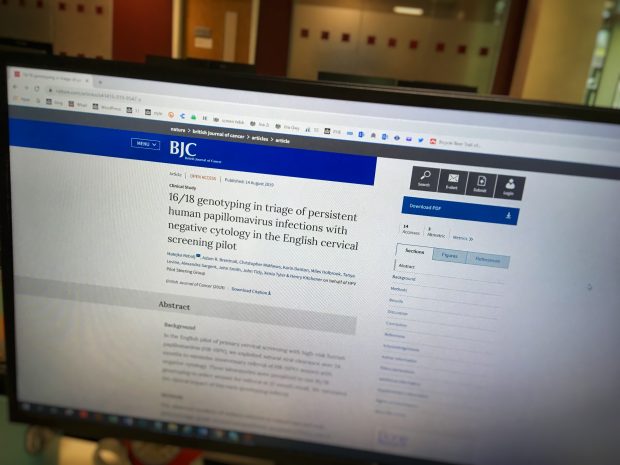
Primary human papillomavirus (HPV) screening is a new way of looking at cervical screening (smear) samples, where the check for HPV is the first test carried out.
Evidence shows doing it this way will cut the number of cervical cancers compared to the current method of looking at cervical cells first in a laboratory (cytology).
HPV is very common and in most people causes no problems as the immune system will clear it away naturally within a year or 2.
However, on rare occasions, high risk types of HPV can stay in the cervix and cause abnormal cells to develop. Over many years abnormal cells can progress into cervical cancer if left untreated.
Two types of high risk HPV, called HPV16 and HPV18, are responsible for about 70% of cervical cancers.
Gathering evidence
In 2013, 6 laboratories in England began looking for HPV in samples first. When HPV is found, cytology is carried out to see whether HPV has caused abnormal cells to develop.
Further tests when abnormal cells are found
If abnormal cells are found then a referral is made for a colposcopy examination, which is a more detailed look at the cervix. If necessary, treatment is carried out to remove the abnormal cells.
Further tests when no abnormal cells are found
When the HPV infection has not caused abnormal cells, a repeat test is taken in 12 months’ time to see whether the HPV has gone away.
If HPV has not gone away and again no abnormal cells are found, another (second) repeat test is taken in a further 12 months.
At this point, 24 months after the first test, if HPV is found again a referral will be made for a colposcopy examination. This would be the third test.
Looking for HPV types 16 or 18
Three of the laboratories tested a variation in the pathway with women who tested positive for HPV, but no abnormal cells were found. Rather than go through the 3 repeat test system as described above, these labs looked to see if HPV types 16 or 18 were there.
If either were found at the initial test and also at the first repeat test, then a referral to colposcopy was made straight away due to the increased risk found with these HPV types.
This allowed experts to consider whether testing for HPV16 and 18 is a better way to manage people with HPV when no abnormal cytology is found.
The findings
The study from the pilots found only a very small increase in the overall number of abnormalities when testing for HPV16 and 18, but the number of colposcopy appointments increased by about 6%.
Matejka Rebolj, Senior Epidemiologist at King’s College London who worked on the pilot, said:
The pilots showed it is safe to continue using cytology testing to decide which HPV positive people need an immediate referral for colposcopy and who can have a repeat test in 12 months. It also found that additional testing for HPV16 and 18 in women with persistent HPV infections would not lead to substantially better disease detection, particularly when women go for their repeat tests.
The cervical screening programme will not be including additional testing for HPV16 and 18 when no abnormal cytology is found.
You can read the results in full in the British Journal of Cancer.
PHE Screening blogs
PHE Screening blogs provide up to date news from all NHS screening programmes. You can register to receive updates direct to your inbox, so there’s no need to keep checking for new blogs. If you have any questions about this blog article, or about population screening in England, please contact the PHE screening helpdesk.